After all of the rain we’ve had this weekend and with more rain coming today and tomorrow, there are going to be a lot of houses throughout the Twin Cities with wet basements. The most common question we get when it comes to wet basements is “how can I fix it?”
While installing drain tile, a sump basket, and a sump pump is nearly a guaranteed way to prevent basement water intrusion, the most important part of preventing basement water intrusion is to control water at the exterior of the home. There are two very basic things that will prevent basement water intrusion in at least 95% of houses: grading and gutters.
By the way, I say 95% conservatively. The number is probably closer to 99%.
Grading
Grading is the first thing to look at if there are water problems at a house. I know this sounds very basic, and it is, but I inspect a ridiculous amount of houses that have poor grading at the exterior. This means that the ground slopes toward the building or allows water to pond next to the building, rather than away. The fix for improper grading is to change the landscaping.
Changing the landscaping to get water flowing away from the house is sometimes as easy as bringing in some dirt next to the house and getting the ground to pitch away from the house. The slope of the dirt away from the house doesn’t need to be anything dramatic – it just needs to be enough to prevent water from sitting next to the house. Just be careful not to pile the dirt too high against the house, because this could lead to rotting at of the wood framing. Try to keep the grade at least 6″ below the top of the foundation wall.
In cities like Minneapolis and Saint Paul, houses will often be too close to each other to allow for proper grading. In these cases, one option is to create a swale in the yard, which will allow for water to go around the house in a type of trench.
When a swale isn’t practical, an underground drain system can be installed in the yard. This system consists of large plastic tubing installed underground that directs surface water to a more desirable location, such as the street. I did this at my last house in Minneapolis many years ago, and it solved my basement water problems. I rented a trenching machine and ending up burying about seventy-five feet of corrugated plastic drain tubing in my yard, and terminated the tubing at the street.
Gutters and Downspouts
The other basic thing to look at when a house has basement water problems is the gutters and downspouts. Without gutters, rainwater can often be concentrated from many different areas on a roof to one single location next to the house, like what’s happening in the photo below. All the highlighted areas dump water in to one single spot next to the house. That’s bad news, and in my opinion, bad design. I covered this type of situation in a post last year titled “Have Your Builder Plan For Water Management.” Gutters would really help to keep water away from the house here.
As I mentioned in the post above, downspouts and downspout extensions are just as important as gutters. I’ve told many clients that it’s better to have NO gutters at all than gutters with improper downspouts.
Why? A house with no gutters will typically disperse water along all of the roof lines. A house with improper downspout extensions will end up concentrating water next to the house.
Again, this is bad news. Proper downspout extensions bring water well away from the house – ideally six to ten feet.
Of course, gutters need to be cleaned as well. Dirty, overflowing gutters are worse than no gutters at all and can actually cause roof leaks.
Sump Systems
If you have a properly functioning sump basket and sump pump in your basement, just make sure the system stays functional. Another home inspector here in Minnesota, Tim Walz, wrote a nice blog post a couple of weeks ago discussing sump pump troubleshooting and failures: http://homeinvestigator.wordpress.com/2014/04/15/is-your-sump-pump-ready-for-spring/ .
At the end of that post, there’s a recommendation for installing a backup sump pump if the system runs all the time, which is certainly a good idea. In fact, it’s probably a good idea to have a backup system even if the pump only runs occasionally. Click this link for more information on different sump pump backup systems.
Conclusion
If you end up with a wet basement this spring, go outside and take a look at how water is being managed at the exterior. Ideally, take a look while it’s raining to make sure the gutters and downspouts aren’t leaking, and to make sure that water isn’t ponding near the building. If this all looks good and you still get water in your basement, the solution might be to have drain tile installed.
If you already have drain tile installed and you’re still getting water in your basement, check for cracks in your foundation walls that could be allowing bulk water through the cracks, which basically bypasses the drain tile. Any such cracks should be repaired. If you’ve checked all this stuff and still can’t figure out the cause of basement water problems, the next step would be to contact a basement water specialist.
To close, here’s a quick news clip that Milind and I did with KSTP News on wet basements in 2011.
Author: Reuben Saltzman, Structure Tech Home Inspections

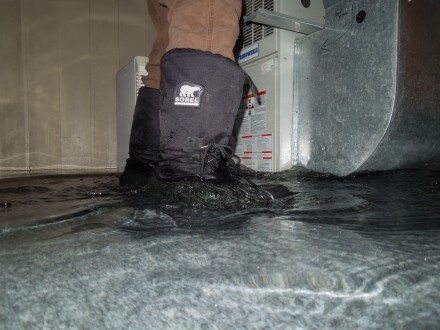
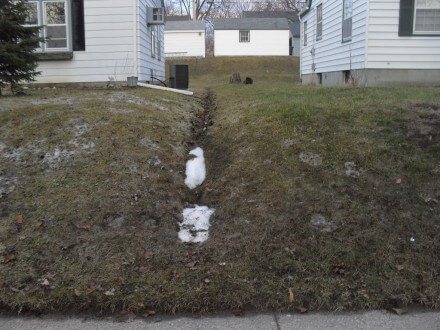
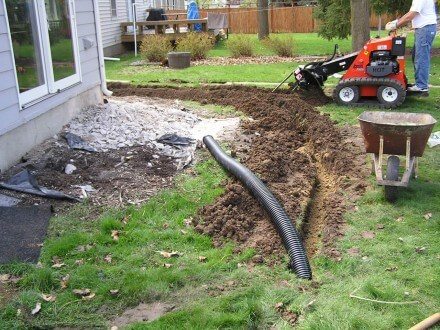
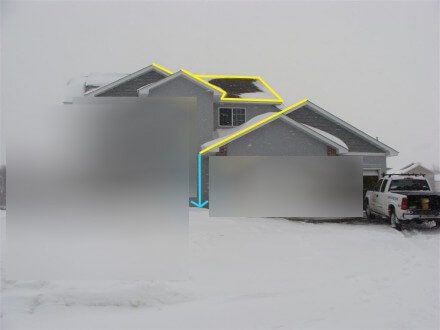
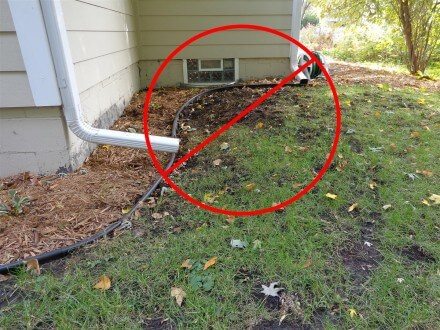
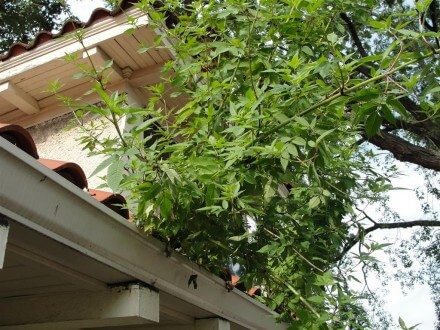
nancy
April 28, 2014, 7:36 am
What do you recommend for gutters- some sort of cover/helmet system, or just replace them with gutters so large that leaves just flow through rather than backing up? Gutters on our house are three stories up in spots, so cleaning gets exciting.
Reuben Saltzman
April 28, 2014, 1:16 pm
@Nancy – there’s no perfect solution, but the gutter covers / helmet systems seem to do a pretty good job of preventing problems.
Steve
April 28, 2014, 2:02 pm
I would love to hear about foundation repair. I have decent grading, drainage and a sump, but my walls are bowing in and the cracks get a millimeter wider every year. With a half-dozen good ways to repair this, I’d love an unbiased assessment of all the options.
Reuben Saltzman
April 28, 2014, 2:13 pm
@Steve – it depends on your goal. I’m no foundation repair specialist, but I usually recommend patching cracks with concrete or some similar product that won’t flex so they can be monitored. This way, if the cracks open up again, you’ll know if there is active movement.
If the goal is to monitor for movement and stop water intrusion, use hydraulic cement. It will stop water movement and it won’t flex.
If the goal is to stop water intrusion, use a polyurethane sealant.
In your particular case, if you have a crack that keeps getting wider every year, you should probably work at figuring out what’s causing the crack and correct the cause, if possible.
Heather
May 1, 2014, 7:39 am
For the underground drain system through your yard, do you have to worry about the plastic corrugated pipe getting clogged with debris? How do you keep stuff like leaves, grass clippings, and maple helicopters out of the pipe?
Reuben Saltzman
May 1, 2014, 2:33 pm
@Heather – the drain pictured in this blog post was a corrugated drain buried below the ground surface, surrounded by class 5 rock. Nothing on the surface has the potential to get into the drain. To help prevent the drain from filling with dirt, I wrapped the drain with landscape fabric. I pitched the soils away from my house and put this yard drain at the lowest point in my yard, then built a deck over it. That way, I didn’t have to bury the yard drain under sod.
Dan
May 1, 2014, 12:24 pm
@Reuben: I see the pic of your backyard drainfield installation…why didn’t you get the socked tubing?
Reuben Saltzman
May 1, 2014, 12:52 pm
@Dan – I wrapped the drain with landscape fabric. Socked tubing probably would have been easier.
Dan
May 1, 2014, 2:20 pm
@Reuben: Cool, thanks. I just noticed the omission in the pic so I figured you had a reason for going without. Thinking of doing something like this in my back yard–very flat and it gets puddled every spring. Only trouble will be navigating the network of silver maple roots!
Agnes
May 4, 2014, 10:02 pm
Have u ever had experience with natural springs under houses causing problems. I live on a hill. 4 inches of rain during week and my small sump pump pushed 1 and half gal out every 2, 3 or 4 min. For the past 6 days. Seeps in thru old floor heat duct system under foundation. Beginning to wonder if deep frost was just coming up now or natural spring underneath.
Reuben Saltzman
May 5, 2014, 3:38 am
@Agnes – I’ve heard of springs under houses causing problems, but never personally dealt with it. That would be one of those situations in the ‘less than 1%’ where proper grading, gutters, and proper downspouts don’t fix the issues. In those situations, it’s wise to have a good backup sump pump in place.
Ben
May 13, 2014, 9:49 am
We moved last summer to a house that gets wet with the rains. We did the landscaping thing around the whole house last fall, by a professional, and use long gutter extensions, there are some leaks in the gutters here and there I need to seal with something (any suggestions?). After all that work and $$, we still got water this spring. We’ve also been getting a lot of standing water about 40′ from the house that takes a couple days to soak in. I’ve had two drain tile quotes for $8000 or so that claim they guarantee a dry basement. I was also told we’re in a high water table area. Since we are in a high water table area, do we fall in that 1% where gutters and grading don’t fully solve the problem? All my basement blocks are exposed and there is no water coming in through the cracks, except for a couple spots at the top of the lowest block – the coloration of the block suggests they are full of water. Thanks
Reuben Saltzman
May 13, 2014, 11:40 am
Hi Ben,
Use gutter seam caulking for the gutters.
Yes, I’d say you’re in that unfortunate 1% where gutters and grading don’t fix everything. It sounds like drain tile will be your next step.
Geoffrey Serdar
May 13, 2014, 10:58 am
Reuben,
This is a great article and I’m going to share it with a few of my clients. It’s very helpful in explaining the simple changes that can make a huge difference in water management.
Proper gutters will always be the least costly fix, I’ve come across many newer builds, mid-2000’s, with improper gutter systems, almost always there is darker mildew buildup on the basement interior walls, not mold, but just a dirtiness, all of which could have been prevented with better gutter systems. Sellers should really look into this, because any type of mildew is an instant turn off for home-buyers, and usually home-buyers aren’t interested in coming in to do any new improvements (installing new gutter systems just isn’t a part of most home-buyers’ comfort zones).
Keep up the good work and educational information!
Truly,
Geoffrey Serdar
http://www.WALZnRUF.com
Housing Consultant + Realtor®
Reuben Saltzman
May 13, 2014, 11:38 am
Thanks Geoffrey!
HOW TO PREVENT BASEMENT WATER INTRUSION | Moisture Removal Rentals
June 23, 2014, 7:22 pm
[…] April 28th, 2014 | 15 comments […]
Meredith Pierce
July 14, 2014, 12:32 pm
Who should we call to get to take care of figuring out our problem? We have water leaking into our finished basement through one corner. We thought we had it fixed through fixing a French drain, but it is now leaking again when we have hard rains. We are past trying to fix it on our own.
Reuben Saltzman
July 14, 2014, 12:36 pm
Hi Meredith, I recommend contacting a company that specializes in basement water intrusion issues. Here’s an example of one: http://www.advancedwaterproofing.net/